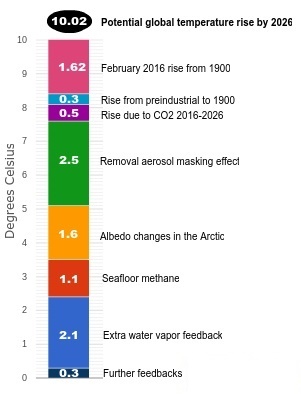Tibor bá’ online
 Az alábbiakban bemutatom Sam Carana kalkulációját. Az úriemberről tudni kell, hogy az egyik legpesszimistább klímakutató. Ennek ellenére kalkulációja logikus. Még azt kell megjegyezni, hogy az optimistább véleményekről az idők folyamán sorra kiderültek, hogy a helyzetet alulértékelték. Egyáltalán nem lehetetlen, hogy Sam Caraná-nak igaza lesz.
Az alábbiakban bemutatom Sam Carana kalkulációját. Az úriemberről tudni kell, hogy az egyik legpesszimistább klímakutató. Ennek ellenére kalkulációja logikus. Még azt kell megjegyezni, hogy az optimistább véleményekről az idők folyamán sorra kiderültek, hogy a helyzetet alulértékelték. Egyáltalán nem lehetetlen, hogy Sam Caraná-nak igaza lesz.
Egyes elképzelések szerint a következő 10 év alatt a globális hőmérséklet emelkedés (az ipari forradalom óta) elérheti a 10,02 °C-ot, az alábbi ábra és részletezés szerint.
![]() 1900-tól – 2016 februárjáig a már megvalósult átlagos hőmérséklet emelkedés 1,62 °C.
1900-tól – 2016 februárjáig a már megvalósult átlagos hőmérséklet emelkedés 1,62 °C.
![]() Az ipari forradalom kezdete óta 1900–ig megvalósult emelkedés 0,3 °C.
Az ipari forradalom kezdete óta 1900–ig megvalósult emelkedés 0,3 °C.
![]() 2026-ig az atmoszférában található széndioxid okozta hőmérséklet növekedés becsült értéke 0,5 °C.
2026-ig az atmoszférában található széndioxid okozta hőmérséklet növekedés becsült értéke 0,5 °C.
![]() Az aerosolok árnyékoló hatásának megszűnéséből származó hőmérséklet emelkedés 2026-ig 2,5 °C. – A számítások szerint 1850 és 2010 között az ember által kibocsátott (antropogén) aerosolok kb. 2,53 °C értékkel csökkentették a melegedést. Ennek figyelembevételével reális azt feltételezni, hogy 2026-ig 2,5 °C emelkedés várható az aerosolok árnyékoló hatásának a megszűnéséből kifolyólag.
Az aerosolok árnyékoló hatásának megszűnéséből származó hőmérséklet emelkedés 2026-ig 2,5 °C. – A számítások szerint 1850 és 2010 között az ember által kibocsátott (antropogén) aerosolok kb. 2,53 °C értékkel csökkentették a melegedést. Ennek figyelembevételével reális azt feltételezni, hogy 2026-ig 2,5 °C emelkedés várható az aerosolok árnyékoló hatásának a megszűnéséből kifolyólag.
![]() A sarkvidéki albedo változástól származó hőmérséklet emelkedés 1,6 °C. – Az albedo változás oka a jég borította terület csökkenése, valamint a havas területek szennyeződése.
A sarkvidéki albedo változástól származó hőmérséklet emelkedés 1,6 °C. – Az albedo változás oka a jég borította terület csökkenése, valamint a havas területek szennyeződése.
![]() A tengerfenékről felszabaduló metán okozta melegedés 1,1 °C. – Ennek oka Dr. Natalia Shakhova által jelzett 50 Gt metán felszabadulása.
A tengerfenékről felszabaduló metán okozta melegedés 1,1 °C. – Ennek oka Dr. Natalia Shakhova által jelzett 50 Gt metán felszabadulása.
![]() A melegedés következtében az atomszférába kerülő további vízpára okozta melegedés (visszacsatolás) 2,1 °C melegedést okoz. – Az atmoszférában található jelenlegi vízpára 7 százalékos emelkedése 1 °C hőmérséklet emelkedést okoz.
A melegedés következtében az atomszférába kerülő további vízpára okozta melegedés (visszacsatolás) 2,1 °C melegedést okoz. – Az atmoszférában található jelenlegi vízpára 7 százalékos emelkedése 1 °C hőmérséklet emelkedést okoz.
![]() További visszacsatolások 0,3 °C. – A fentiek következtében az atmoszférában több vízpára, és energia gyűlik össze, ami erőteljesebb viharokat, villámlásokat és áradásokat okoz. Az áradások elősegítik a növények rohadását, ami további metán keletkezését jelenti. A villámok ózont hoznak létre. A magasabb hőmérséklet és gyakoribb villámok több erdőtüzet okoznak, ami CO2 keletkezést jelent.
További visszacsatolások 0,3 °C. – A fentiek következtében az atmoszférában több vízpára, és energia gyűlik össze, ami erőteljesebb viharokat, villámlásokat és áradásokat okoz. Az áradások elősegítik a növények rohadását, ami további metán keletkezését jelenti. A villámok ózont hoznak létre. A magasabb hőmérséklet és gyakoribb villámok több erdőtüzet okoznak, ami CO2 keletkezést jelent.
Összességében 2026-ig 10,02 °C globális hőmérséklet emelkedés várható.
_________________________________________________________
Az eredeti angol szöveg:
Rise from pre-industrial levels to 1900 (0.3°C)
Additional warming was caused by humans before 1900. Accordingly, the next (light blue) element from the top down uses 0.3°C warming to reflect anthropogenic warming from pre-industrial levels to the year 1900.
Rise due to carbon dioxide from 2016 to 2026 (0.5°C)
The purple element reflects warming due to the amount of carbon dioxide in the atmosphere by 2026. While the IEA reported that energy-related carbon dioxide emissions had not risen over the past few years, carbon dioxide levels in the atmosphere have continued to rise, due to feedbacks that are kicking in, such as wildfires and reduced carbon sinks. Furthermore, maximum warming occurs about one decade after a carbon dioxide emission, so the full warming wrath of the carbon dioxide emissions over the past ten years is still to come. In conclusion, an extra 0.5°C warming by 2026 seems possible as long as carbon dioxide levels in the atmosphere and oceans remain high and as temperatures keep rising.
Removal of aerosols masking effect (2.5°C)
With dramatic cuts in emissions, there will also be a dramatic fall in aerosols that currently mask the full warming of greenhouse gases. From 1850 to 2010, anthropogenic aerosols brought about a decrease of ∼2.53 K, says a recent paper. While on the one hand not all of the aerosols masking effect may be removed over the next ten years, there now are a lot more aerosols than in 2010. A 2.5°C warming due to removal of part of the aerosols masking effect therefore seems well possible by the year 2026.
Albedo changes in the Arctic (1.6°C)
Warming due to Arctic snow and ice loss may well exceed 2 W per square meter, i.e. it could more than double the net warming now caused by all emissions by people of the world, calculated Professor Peter Wadhams in 2012. A 1.6°C warming due to albedo changes (i.e. decline of both Arctic sea ice and snow and ice cover on land) therefore seems well possible by the years 2026.
Methane eruptions from the seafloor (1.1°C)
„. . we consider release of up to 50 Gt of predicted amount of hydrate storage as highly possible for abrupt release at any time,” Dr. Natalia Shakhova et al. wrote in a paper presented at EGU General Assembly 2008. Authors found that such a release would cause 1.3°C warming by 2100. Note that such warming from an extra 50 Gt of methane seems conservative when considering that there now is only some 5 Gt of methane in the atmosphere, and over a period of ten years this 5 Gt is already responsible for more warming than all the carbon dioxide emitted by people since the start of the industrial revolution. Professor Peter Wadhams co-authored a study that calculated that methane release from the seafloor of the Arctic Ocean could yield 0.6°C warming of the planet in 5 years (see video at earlier post). In conclusion, as temperatures keep rising, a 1.1°C warming due to methane releases from clathrates at the seafloor of the world’s oceans seems well possible by the year 2026.
Extra water vapor feedback (2.1°C)
Rising temperatures will result in more water vapor in the atmosphere (7% more water vapor for every 1°C warming), further amplifying warming, since water vapor is a potent greenhouse gas. Extra water vapor will result from warming due to the above-mentioned albedo changes in the Arctic and methane releases from the seafloor that could strike within years and could result in huge warming in addition to the warming that is already there now. As the IPCC says: „Water vapour feedback acting alone approximately doubles the warming from what it would be for fixed water vapour. Furthermore, water vapour feedback acts to amplify other feedbacks in models, such as cloud feedback and ice albedo feedback. If cloud feedback is strongly positive, the water vapour feedback can lead to 3.5 times as much warming as would be the case if water vapour concentration were held fixed”, according to the IPCC. Given a possible additional warming of 2.7°C due to just two elements, i.e. Arctic albedo changes and seafloor methane, an additional warming over the next decade of 2.1°C due to extra water vapor in the atmosphere therefore does seem well possible by the year 2026.
Further feedbacks (0.3°C)
Further feedbacks will result from interactions between the above elements. Additional water vapor in the atmosphere and extra energy trapped in the atmosphere will result in more intense storms and precipitation, flooding and lightning. Flooding can cause rapid decomposition of vegetation, resulting in strong methane releases. Furthermore, plumes above the anvils of severe storms can bring water vapor up into the stratosphere, contributing to the formation of cirrus clouds that trap a lot of heat that would otherwise be radiated away, from Earth into space. The number of lightning strikes can be expected to increase by about 12% for every 1°C of rise in global average air temperature. At 3-8 miles hight, during the summer months, lightning activity increases NOx by as much as 90% and ozone by more than 30%. The combination of higher temperatures and more lightning will also cause more wildfires, resulting in emissions such as of methane and carbon monoxide. Ozone acts as a direct greenhouse gas, while ozone and carbon monoxide can both act to extend the lifetime of methane. Such feedbacks may well result in an additional 0.3°C warming by the year 2026.
_________________________________________________________
_________________________________________________________
_________________________________________________________
